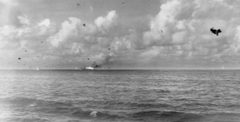
Above: Claxton hit. Below: Claxton with Killen and Canberra in dry dock at Manus.
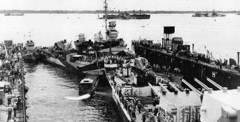
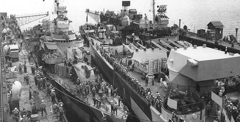
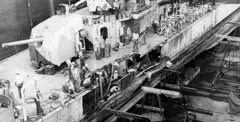
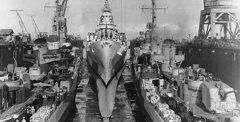

They were called “kamikaze” by the Japanese. US sailors called them “suicide planes.”
Claxton was at General Quarters with Condition One Easy set, responding to the warning of many incoming bogeys. We had been at GQ, fully manned and ready for battle for days. The crew was showing signs of exhaustion. Captain Hubbard made the decision, acknowledging my advice as damage control officer, to make things a little more livable aboard ship. He relaxed the watertight integrity required by material condition ALPHA during battle. He ordered one watertight door in each living compartment be left open, staggering the doors from port to starboard so that air could flow through the hot ship.
On a Fletcher-class DD, the deck in the living spaces aft is at the waterline. Damage to the after part of the ship at the waterline, with those doors open, could flood the after one-third of the ship.
During the attack, our 5-inch and 40mm rounds could be seen hitting the “Val” aircraft as it dived toward the ship, but it kept on coming straight for us. When the alarm sounded for setting Condition One, I was on watch in CIC, located in officer country, just forward of the mast on the main deck, The XO said, “It looks just like old times. I relieve you.” I then bounded out onto the main deck and began running to my battle station in DC Central, in the amidships passageway. Having been on watch in CIC, I was fully aware of what was happening.
As I ran down the main deck, I looked up and saw that Val coming down. I can remember vividly seeing that round spinner on the prop and those two wheels that hung below the fuselage that were coming straight toward me. Frantically, I turned around and began running forward. When I looked up again, that Val was still coming straight at me. Me! I turned around and started running aft again. I was running as fast as I could . . . toward the spot where the plane was about to hit. Its wing struck the high 40mm gun mount aft, cutting the first loader’s head off as the fuselage just missed the ship. But, the estimated 500-pound bomb loaded beneath the belly of the plane exploded and blew a fifteen-foot by five-foot hole in the starboard quarter just opposite the 5-inch upper handling room. The blast blew out the compartment and all the watertight doors in the after living spaces, killing one of the gun crew ammunition handlers in the compartment. The bomb was apparently a fragmentation type that forced small holes in the deck house over an immense area, wounding a whole host of men whose battle stations were in the after part of the ship, starboard side.
Running down into the compartment, I found 440-volt wires swinging live and free, sparking every time they touched a bulkhead or bunk as the ship rolled; acrid smoke, several crew members who were stunned by the explosion and one man who had been killed instantly by bomb fragments. The wounded were evacuated first while I put together a damage report to the bridge.
Running up the ladder to topside, I grabbed the sound powered telephone from the depth charge operator and gave the captain my report of estimated damage, and casualties below.
The ship was in a tight turn to starboard, attempting to avoid other planes diving on her. The heeling, as a result of the tight turn starboard, kept the hole in the side out of the water and no flooding had occurred. Every watertight door that was open had been distorted beyond the possibility of closing, and the doors that had been dogged shut were bent beyond the possibility of opening them. If that hole should go below the waterline, the entire ship aft of the after engine room, one-third of the ship, would be immediately flooded with free surface effect water.
All of that information was passed to the captain with a strong warning that any turn to port would put the hole under water, and we might sink! With the confidence that the hole would be kept out of the water, I returned below to continue salvage work.
The captain acknowledged my warning, but took little stock in my assessment of the damage. In the heat of battle, the OOD, Bill Hogan, put the rudder hard over to port to try to avoid another suicide plane. In one fast moment, the entire area of the ship aft of the after bulkhead of the after engine room was flooded with free-surface effect water.
When the water rushed in, the petty officer in charge of the magazine located below the living compartment, reached up and closed the hatch giving access to the magazine. This kept that area from flooding, but it also erased the possibility of escape from that magazine should the ship go down. At best, if we stayed afloat, the men in that magazine could not get out until we got the water out of the ship. This left them trapped underwater for hours to think about that damned petty officer that locked them in with the possibility of going down with the ship. He caught hell from the other two men who were trapped in that magazine with him. But, as a result of that heroic action, he kept ammunition going up to the after 5-inch guns to keep them firing.
When the below decks area suddenly flooded, the gunner’s mate in charge of the upper handling room, Gail Fiscus, and I were left swimming with a couple of feet of air space between the water level and the compartment overhead. Fiscus hollered, “What do we do now?” I told him we would dive down and swim into the upper handling room; and escape up into the after 5-inch gun mount through the powder scuttle that allows passage of ammunition to the mount in case of power failure to the hoist.
My first task was to reappraise the damage situation and report to the captain. I was mad as hell. I had advised the captain not to open those watertight doors; and after the hit by the suicide plane, I had advised him not to turn to port. He had not taken my advice and we had darned near lost the ship.
Consulting the flooding diagrams, I found that our fully-loaded righting moment, the geometric metacenter (GM), had suddenly been reduced to 0.02 feet. (The geometric metacenter is a measure of the ship’s ability to return upright after rolling to one side or the other.) Shifting weights by any means just might create a further loss of righting moment. We dared not counterflood, for taking on more water would result in the loss of stability due to that compartment taking on the weight of the water, creating a moment of force that could roll the ship over.
An outside force, like the bow wave of another ship passing close aboard, could cause the ship to roll over. We were in a “lolling” status where the ship rolls to one side and hangs there; stopping just before rolling over. Such an outside force could also cause the ship to roll to the other side and hang again just before her momentum rolled her on over, if the force that caused the initial roll were not quite strong enough.
Wouldn’t you know that our first skipper, now-Captain Herald F. Stout, was riding in his division flagship nearby, and came running by close aboard to starboard? His bow wave caused the ship to roll to port creating a list that nearly capsized the ship. He sent over a flashing light message, “Tsk, tsk. All that trouble over a piece of tail.” At that moment I could have killed him.
I intercepted a recommendation from the chief engineer to counterflood forward in an attempt to raise the hole out of the water. As strongly as I could, I pleaded with the captain not to counterflood for it just might be the act that caused us to sink.
Our first priority was to get the free surface effect water off the ship. With all of our pumps, we could not pump out more water than was coming in through that 15-foot hole that now was below the water line. We had to, somehow, close that hole and restrict the water coming aboard. Here, again, Damage Control School paid off. School personnel demonstrated making a hull patch by securing four mattresses to a sleeping bunk sheet bedspring and covering the hole to restrict water flow. Our Damage Control party put together enough of those patches to cover the hole. As each set of mattresses was lowered over the side, Ensign John Tiedeberg, Assistant Damage Control Officer, dived into the water-filled compartment and secured the patch in place, to a point inside the ship.
Voila! We were able to pump more water out than was coming in. In the forward gunners mates living compartment there is a manhole cover providing access to the starboard shaft alley. One of the Damage Control team men was able to dive and remove the bolts from that manhole cover. Immediately, water gushed into the shaft alley. The after engine room bilge pumps were put on the line and they immediately took suction on the shaft alley water and sped up immensely the capability to get rid of the flooding water. We raised the stern sufficiently to get the hole above the water and were able to pump the ship dry in about six hours.
On seeing Claxton’s condition, the USS Abner Read, another Fletcher-class DD, came over to us and lay-to alongside. They put a boat in the water and sent over their doctor, hospital corpsmen, and their Damage Control party to help us out wherever they could.
Within minutes, another suicide plane spotted the disabled Claxton and Abner Read alongside, a double target dead in the water. That plane dived, just missing Claxton and crashed into Abner Read amidships, port side.
The bomb that plane brought down with her exploded into the 40mm magazine port side, main deck, igniting the gasoline that splashed all over that area. The combination of the bomb blast and the flash gasoline fire set off the 40mm ammunition. The gasoline fire enveloped the forward torpedo tube mount and its operator. The torpedoman, realizing the danger that the torpedo warheads might explode, trained the mount outboard, away from Claxton, and fired all five torpedoes by hand with a mallet, firing them over the side. He did this while totally engulfed in flames.
On spotting this, Captain Hubbard on Claxton warned the battleships that five live torpedoes were running hot, straight, and normal right at the battleship formation. Black smoke belched from the old battlewagons in an effort to get out of the way of the torpedoes. Fortunately, none were hit.
On the main deck of Abner Read, fire and exploding 40mm ammunition penetrated the fire-inch magazine setting it ablaze, blowing the bottom out of the ship.
With our damage stabilized and pumping beginning to dewater the ship, I went topside and became involved in fighting the fires on Abner Read and rescuing her crew who were in the water. The Supply Officer, Lt. (jg) Ben Wallace, and I ran forward to the bow, the closest point to Abner Read. We rigged fire hoses with spray nozzles in an attempt to cool down the 40mm ammunition locker and the forward part of the ship, topside. The two ships were close enough that we were able to reach that locker with our spray.
The heat from the fire was so hot it set off explosions of 40mm and five-inch ammunition. All at once white hot metal was flying at us, fully exposed between mount one 5-inch gun mount and the forward deck house. I swear that Claxton carried an impression of my body in that main deck, caused by my pressing down so hard to avoid flying white-hot metal.
The entire crew, without an abandon ship order, began jumping over the side. Explosions continued as Abner Read rolled over and sank stern first within minutes.
All this was going on while we were trying to dewater the ship and care for our wounded.
The task began for a crippled Claxton to rescue those men who had come to her rescue. We rigged a ladder over the side and threw life jackets and anything that was loose and would float, over the side. Some grabbed lines we rigged and tried to hold on. As we grabbed those men and attempted to haul them out of the water, large chunks of their burned flesh came off in our hands.
We then rigged sheet bed springs with a bridle and lowered them over the side for the men to swim over onto them. We were able to seine the men out of the water and bring them aboard without having to put our hands on them.
The Claxton and Abner Read medical teams began a hectic rescue mission all over again. Claxton wardroom had become an operation room for the doctors, Lt Brown and the Abner Read medical team caring for our wounded. They hadn’t been able to get ahead of that task when the wounded and burned from Abner Read were brought aboard. Had Abner Read not sent her medical team over to help us out, all their medical personnel would have been killed when the suicide plane struck close to the sick bay. Claxton rescued 198 men from Abner Read and another destroyer rescued another 100 or so, with losses of only 14 lives aboard Abner Read.
The organized kamikaze attack was going on through all of this. We sent all rescued personnel below to the mess hall for their protection. This put a lot of weight that those men represented, down low in the ship, improving our stability, now that we were successfully dewatering the ship. We, also, had to get them out of the way as we continued to fight the ship. Every time the sound of the hydraulic drive of the gun mounts lit off, they knew a plane was close and making another attack on us. They refused to stay below, scared to death that another ship would be blown out from under them.
We were able to dewater the ship and proceed under our own power to an anchorage off Tacloban air strip where wounded and dead were transferred.
Since our guns could still fire, Claxton was assigned a call-fire mission to attack artillery positions located over a nearby hill from the air strip. This required reverse slope firing to lob our shells over the hill and drop down on those gun positions from which the Japs were lobbing shells over the hill, hitting the airstrip, facilities and aircraft. This firing continued 24 hours a day. We had to be a battle stations, but were able to relax to Condition One Easy, and rotate ready guns and crews. This allowed some men to sleep on station. Rotation of the ready guns allowed some respite, but the continual gunfire took its toll, resulting in mass fatigue throughout the crew.
While bombarding at anchor off Tacloban one day, a Jap torpedo plane came around the hill we were firing at and dived right down close to the water, heading straight for the ship. Our 5-inch battery could not change targets rapidly enough to take it under fire, but 20mm and 40mm batteries opened up. He was heading straight for us. I thought, “Here we go again.” We could not stop him. He suddenly pulled up and passed right over us, diving back down, skimming the water. He had spied the cruiser, Honolulu, a much more valuable target. He loosed his torpedo and got away over the nearby island of Samar, as the fish blew the bottom out of the Honolulu. They never saw him coming and never fired a shot at him.
The captain recommended me for the Bronze Star medal for my actions in fighting the damage from the kamikaze. The award was reduced to a Letter of Commendation with Combat “V.”
The petty officer in charge of the lower handling room aft was awarded the Silver Star medal for his actions in sealing off the five-inch magazine from flooding and eliminating any hope of escape should the ship sink. On reassessing the damage to the ship and the loss of stability, I learned that had that magazine flooded, the ship would have lost enough GM righting moment to roll the ship over and sink.